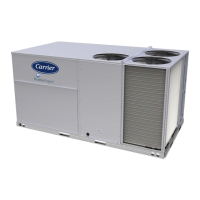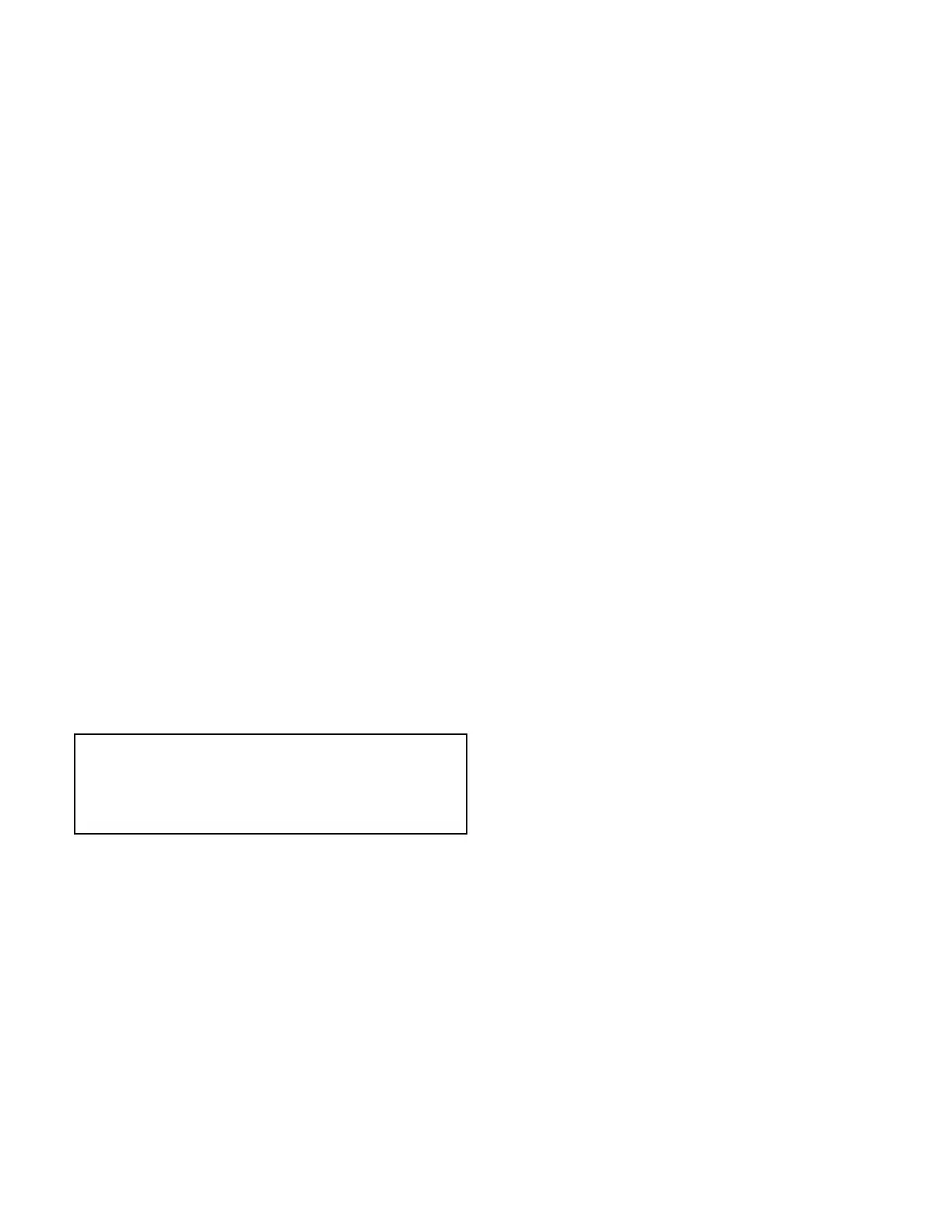19
activate the use of the ventilation speed wire, the Number of
Speeds (SETTINGS UNIT CONFIGURATIONS IN-
DOOR FAN NUMFSPDS) configuration must be set to 3.
The Commanded Fan Speed (OUTPUTS INDOOR FAN
FANS PEE D) represents the control’s commanded speed for the
fan at any given time. This commanded speed is determined by
the unit’s current HVAC mode and the unit control type. For gas
heating units, the IGC fan request output (Inputs GEN.I
IGC.F) is monitored by the control. This can result in additional
modification of fan delays or other operation due to safety func-
tions of the IGC control. See “Heating Operation” on page 25
for more details. If configured for IAQ fan operation, the fan
may be turned on to satisfy air quality demands. See “Indoor Air
Quality (IAQ)” on page 30 if using IAQ (indoor air quality) ac-
cessory sensors. The fan can run under thermostat or space sen-
sor control and will remain on if compressors or heat relays are
ever stuck on. If Shut Down on IDF Failure is enabled (SHUT-
DOWN IDF FAIL = Yes), the fan and unit will be shutdown
without delay on fan alarm conditions. Fan off delays are hon-
ored when exiting specific HVAC modes. The Fan-off Delay de-
lays are as follows: Cooling (COOL FANOFF DELAY), and
Heating (HEAT FANOFF DELAY).
Indoor (Supply) Fan Maximum Speed (MAXIMUM IDF
SPEED)
Max speed is the highest fan speed allowed. This is typically
100% when pulleys are set to deliver design CFM to the space
per job requirement. Most safety conditions for the unit will
override the fan speed to this to help protect the unit.
Ventilation Indoor Fan Speed (VENT IDF SPEED)
This configuration defines the fan speed used in Ventilation (fan-
only) mode. Ventilation mode is when the supply fan is running,
but there is no demand for heating or cooling. In thermostat
mode, this is with just a G call. In space sensor control, this is
when the unit is Occupied mode and the indoor fan is configured
to always run while occupied (OCCUPIED FAN?). If the indoor
fan is configured for intermittent fan (OCCUPIED FAN? = No),
the Mode will be off instead of Ventilation and the fan will not
run unless a heating or cooling mode is needed. During the unoc-
cupied period, the fan will always operate intermittently. The
economizer damper will adjust its position based on how far
away this speed is from max speed for ventilation.
Heating Indoor Fan Speed (HEATING IDF SPD)
This configuration defines the fan speed used when in heating
mode and running heat. On units equipped with gas heat (UNIT
TYPE OF HEAT), this heat speed will be delayed on based on the
IGC’s fan on call (IGC FAN REQUEST). Once the IGC requests
the fan, the fan will run what this heating speed configuration is
set for until heating is ended. On units configured for electric heat
(UNIT TYPE OF HEAT) and configured for Preheat without the
fan (PREHEAT W/O IDF), this heat speed will be delayed on
based on the Preheat fan delay time (PREHEAT FAN DELAY).
Once this preheat time has expired or not configured for preheat,
the fan will run at this heat speed while heat is on.
Free Cooling Indoor Fan Speed (FREE COOL IDF SPD)
This configuration defines the initial fan speed used when in Free
Cooling. Refer to “Economizer Operation” on page 27 for details
on free cooling. The fan will stay at this configured speed whenev-
er only the damper is being used for free cooling. If the damper is
at 100% for 5 minutes, the fan will ramp to the high cooling speed.
It is locked there until the actual damper position falls below 75%,
at which time it will ramp back down to this configured speed.
Low Cooling Indoor Fan Speed (LOWCOOL IDF SPD)
This configuration defines the fan speed used when only one
stage mechanical cooling is being performed.
Medium Cooling Indoor Fan Speed (MED COOL IDF SPD)
This configuration defines the fan speed used when only sec-
ond stage mechanical cooling is being performed.
High Cooling Indoor Fan Speed (HIGH COOL IDF SPD)
This configuration defines the fan speed used when third (full
load) stage mechanical cooling is being performed. When per-
forming integrated cooling with the economizer, this speed will
be used. When only free cooling with a high cool demand, this
speed will be used.
Cooling Operation
The 48/50LC unit’s cooling operation consists of: demand and
mode determination, staging request to satisfy the demand, and
handling a request with the unit’s resources. These resources
can include compressors, Humidi-MiZer
®
system, an econo-
mizer, and fan speed based on options. This section covers me-
chanical cooling. For economizer free cooling, refer to “Econ-
omizer Operation” on page 27.
For Humidi-MiZer system operation, refer to “Optional Humi-
di-MiZer Dehumidification System” on page 21.
COOLING MODE CONTROL
The cooling HVAC mode (OPERATING MODE) has 9 differ-
ent operating sub modes (SUBMODE): ECON FREE COOL-
ING, UNOCC. FREE COOL, MECH. COOLING, ECON/
MECH COOLING, DEHUMIDIFICATION, DEHUM/MECH
COOLING, DEHUM PREVENTED, COOLING PREVENT-
ED, and SHUTTING COOL OFF. These are all part of a gen-
eral cooling mode and resemble the specific type of cooling
that is being performed at any given time. All types of cooling
are still performed under the general cooling function, and the
expanded text is for user reference only.
For the unit to enter cooling mode, three things must be true:
the indoor fan must be ok to use, the mode changeover time
guard must be expired, and there must be a cooling or dehu-
midification demand (Y1, Y2, Y3, space cool demand, or hu-
midity demand). The unit will remain in cooling for at least
one minute or until any of the above conditions turn false. The
cooling mode does not officially end until the compressor is off
and the fan off delay has expired.
COOLING STAGING CONTROL
Once the unit is in a cooling mode, determine what the demand is
and how to satisfy it. If an economizer is installed and can be used
for cooling (OK TO USE FREE COOLING? = Yes), the unit will
use it first (see “Economizer Operation” on page 27 for its opera-
tion). If the economizer cannot be used or additional cooling is
needed, a mechanical cooling check is performed. OK to use
Compressors? (OK TO USE COMPS?) will be set to yes when
the outdoor temperature (OUTDOOR AIR TEMP) is above the
Circuit A Lockout temperature (CIR.A LOCKOUT OAT) and the
Circuit A is not locked out for diagnostic reasons (CIRCUIT A
LOCKOUT). Based on the unit control configuration, requested
cooling stages (REQ. COOL STAGES) will be determined then
passed to compressor control to actually add the cooling stages.
There are two ways of requesting stages when thermostat control
is enabled: traditional thermostat control or adaptive control. Tra-
ditional thermostat control is used if set for non-adaptive
thermostat (ADAPTIVE TSTAT = NO) and the unit cannot use
the economizer for free cooling. If set for adaptive thermostat
(ADAPTIVE TSTAT = YES) or any time the economizer is avail-
able for free cooling, the unit will use adaptive control for staging.
When configured for space sensor or RAT control (UNIT CON-
TROL TYPE), the unit will use adaptive control for staging.
With either staging method there are two supply air temperature
limits that apply, one restricts more cooling stages and the other
IMPORTANT: It is important that the ventilation rate is
checked after setting this speed to verify that the unit can
properly ventilate the space per requirements. Adjusting
this configuration or the economizer minimum setting
curve should be performed to meet job requirements.

